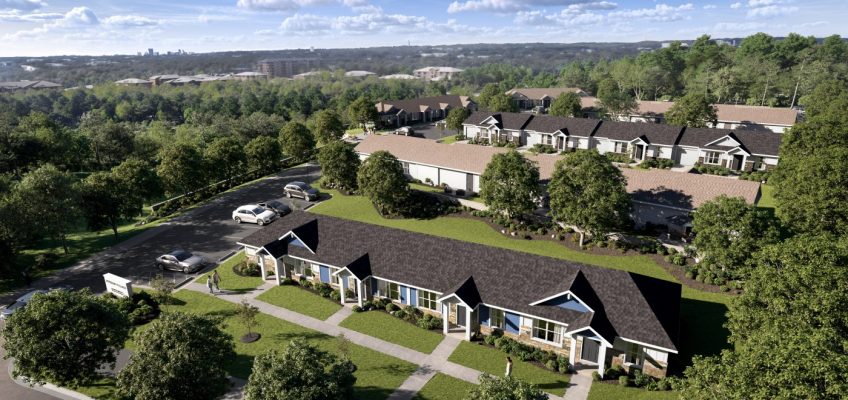An ambitious plan to make sure those who served in the Armed Forces have a roof over their head when they return took another step forward Wednesday as housing advocates and veterans support groups broke ground on a veterans housing neighborhood in Eagan.
All told, the $5.5 million Veteran Village project includes 22 homes for up to 36 veterans and their families who are experiencing homelessness, spread across more than 6 acres on the 3900 block of Rahn Road. It’s the latest effort to help veterans needing assistance securing permanent housing, led by local partners including the Housing First Minnesota Foundation, Lennar homes, the Minnesota Assistance Council for Veterans and Mount Calvary Lutheran Church.
An architectural rendering of Veterans Village, an ambitious plan aimed at combating homelessness among veterans, will include 22 homes across six acres in Eagan. (Courtesy of Lennar)
With construction underway, it caps off two years of planning, including finding a site, purchasing the acreage, receiving city approval and developing blueprints for the homes. Housing First and the Minnesota Assistance Council for Veterans began partnering in 2017 with the construction of the first single-family home for members who had served in the Armed Forces. The 15th such home is currently under construction. The Housing First Foundation Veteran Housing Initiative has already developed more than 39,500 square feet of supportive housing since 2017.
“It’s a major sense of pride to be involved in a project like this,” said Jon Lovald, chief operating officer of the Minnesota Assistance Council for Veterans.
Lovold served 25 years in the U.S. Army, retiring in 2015 as a lieutenant colonel, and also served with the Minnesota National Guard as the director of human resources for the active Army and National Guard workforce.
There are more than 200 veterans on the Minnesota Homeless Veteran Registry, a tally that two years ago topped 400 people.
Lovold said MACV assists more than 1,800 veterans annually stay housed, as another 600 veterans become homeless each year.
That list is fluid, he said, as people transition into and out of different circumstances.
“The key is that we outpace the rate of names going off of the list, rather than going on,” Lovold said, comparing the constant need to how an emergency room operates. When one person’s needs are fulfilled, another person needing help emerges.
“The list is never going to be zero. The system has to exist,” Lovold said.
A village for vets
Whereas previous homes in the partnership were single-family structures spread out over the metro area, this latest effort allows MACV to closely assist veterans with case management as they transition into the next period of civilian life, he said.
Lovold recalled retiring after 25 years, and reaching a certain set of financial and medical benefits that helped him find solid footing as he transitioned away from the Army and National Guard. He concedes that is not a typical situation — many others deal with a much different set of circumstances. For many veterans, the Armed Services provided a way to leave at-risk situations, or troublesome situations at home.
“You’re in the military, learning all of these other skill sets, but that doesn’t change what has been happening at home, four, eight, 10 years while you were gone,” Lovold said.
Related Articles
Veterans are divided over the Army’s big parade, being held on Trump’s birthday
Benefits resource fair, claims clinic set for Ramsey County vets
D-Day veterans return to Normandy to mark 81st anniversary of landings
The man whose weather forecast saved the world
WWII vets are rock stars in France as they hand over the duty of remembering D-Day
The Veteran Village setup, with a case management office near the homes, can fill some of those gaps in life skills that are badly needed, he said.
The first building in the complex is on track to be completed by September, said Sofia Humphries, senior director of community impact with Housing First. The remaining homes are on track to be completed later this year or early 2026.
The first building also will be part of the Parade of Homes tour.
Veteran Village will include four one-bedroom units, 11 one-bedroom units with a garage, and seven three-bedroom units for families.
“Contributors from big to little have stepped up and contributed to the project,” Humphries said. “It has been a really unifying project.”


Leave a Reply